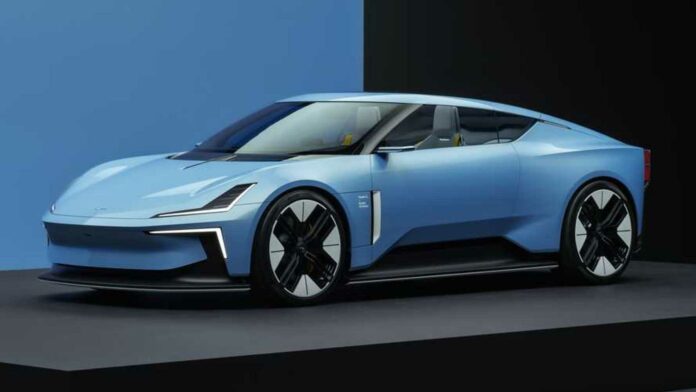Polestar 6
In recent years, the electric vehicle (EV) market has witnessed a paradigm shift, with traditional notions of performance and luxury being redefined by innovative automakers. Polestar, a prominent player in this evolving landscape, has made a significant impact with its latest offering, the Polestar 6.
Electric Roadster
Initially planned as a limited-edition electric roadster, the overwhelming demand has prompted the company to adopt a demand-based production strategy. This strategic pivot not only highlights the growing consumer interest in high-performance EVs but also marks a notable shift in how automakers respond to market dynamics. This discussion delves into the implications of Polestar’s approach, examining how it reflects broader trends in the automotive industry and what it signifies for the future of electric mobility.
Demand-Based Production
Polestar 6 production to be based on demand
- Polestar initially announced that it would build just 500 examples of the Polestar 6 electric roadster, but has since decided to produce the car based on demand.
- All 500 build slots for the Polestar 6 were reserved within a week of the car’s production announcement.
- Polestar CEO Thomas Ingenlath has confirmed that the company “would not stop at 500 if people want it.”
- The Polestar 6 will be powered by a dual-motor powertrain with 884 horsepower and 664 pound-feet of torque.
- The Polestar 6 is expected to accelerate from 0 to 62 mph in just 3.2 seconds and have a top speed of 155 mph.




Innovation in Automotive EV with Sustainable Luxury
The news about the Polestar 6 and its production strategy reflects an interesting approach in the automotive industry, particularly in the electric vehicle (EV) segment. Polestar’s decision to switch from a limited production run to a demand-based model shows its flexibility and responsiveness to market interest. Here are some key points and implications of this strategy:
- High Demand for Electric Roadsters: The quick reservation of all 500 build slots for the Polestar 6 indicates a strong market interest in high-performance electric roadsters. This demand might be driven by a combination of factors such as the appeal of sustainable driving, the performance characteristics of EVs, and the unique design of the Polestar 6.
- Production Strategy: Moving to a demand-based production approach allows Polestar to maximize its market potential while avoiding overproduction. This strategy is particularly useful in the EV market, where consumer interest can fluctuate based on factors like technology advancements, government policies, and infrastructure development.
- Technical Specs Appeal: The impressive technical specifications of the Polestar 6, such as its powerful dual-motor powertrain and rapid acceleration, are likely key factors in its popularity. These features show that electric vehicles can compete with traditional internal combustion engine sports cars in terms of performance.
- Concept to Production: The transition of the Polestar O2 concept into the production-ready Polestar 6 demonstrates Polestar’s commitment to innovation and customer interest. This might set a precedent in the industry for more concept vehicles making it to production, especially if they generate substantial consumer interest.
- Market Trends: The success of the Polestar 6 could influence other automakers in the luxury and sports car segments to invest more heavily in electric models. It could lead to a wider range of high-performance EVs in the market, catering to the needs of enthusiasts and eco-conscious consumers alike.



High-Performance
Key Analysis
The decision by Polestar to shift from a limited production run to a demand-based approach for the Polestar 6 electric roadster provides several key insights into both the company’s strategy and the broader electric vehicle (EV) market:
- Market Demand and Consumer Preferences: The quick reservation of all initial 500 build slots for the Polestar 6 highlights a strong market demand for high-performance electric vehicles. This interest from consumers signals a shift in preferences towards EVs that do not compromise on luxury and performance, challenging the traditional dominance of petrol-powered sports cars.
- Flexibility in Production Strategy: By adopting a demand-based production model, Polestar is demonstrating a flexible approach to manufacturing. This strategy allows the company to adjust production in line with market demand, reducing the risks associated with overproduction and inventory management. It also suggests a lean and responsive manufacturing system that can adapt to changing market conditions.
- Brand Positioning and Market Influence: Polestar’s decision can influence other automakers in the luxury and performance segments. As they witness the success of a high-performance EV like the Polestar 6, it may encourage more manufacturers to invest in and develop similar electric models, further expanding the market.
- Technological Advancements: The technical specifications of the Polestar 6, including its 800-volt architecture and powerful dual-motor setup, underscore the rapid advancements in EV technology. Such developments are not only pushing the boundaries of EV performance but also helping to overcome some traditional barriers to EV adoption, like range anxiety and performance concerns.
- Sustainability Meets Performance: The Polestar 6 bridges the gap between sustainability and high performance, catering to a niche but growing segment of consumers who are environmentally conscious yet desire the performance and aesthetics of traditional sports cars. This aligns with broader societal trends towards sustainability, without sacrificing the thrill and prestige associated with high-end automobiles.
- Concept to Production Transition: The journey of the Polestar 6 from a concept (the O2 concept) to a production-ready vehicle, driven by consumer interest, highlights the importance of market feedback in the automotive design and production process. It shows a customer-centric approach where consumer interest can directly influence production decisions.
- Global EV Market Dynamics: This strategy reflects broader trends in the global automotive market, where there’s increasing competition and innovation in the EV sector. As more consumers show readiness to adopt EVs, automakers are being pushed to offer diverse options that cater to various preferences and needs.
Consumer Demand for EVs
Competitors
The Polestar 6, as a high-performance electric roadster, is positioned in a relatively niche segment of the electric vehicle (EV) market. Its competitors are a mix of established luxury brands and new entrants focusing on electric performance vehicles. Here are some key competitors:
- Tesla Roadster: Perhaps the most direct competitor, the upcoming Tesla Roadster promises exceptional performance with groundbreaking acceleration and range figures. Tesla’s strong brand presence and technological prowess make the Roadster a significant contender in the high-performance EV space.
- Porsche Taycan: While not a roadster, the Porsche Taycan offers high performance and luxury in an electric package. Its reputation, coupled with Porsche’s legacy in sports cars, positions it as a competitor for customers looking for performance-oriented EVs.
- Audi e-tron GT: Audi’s foray into high-performance EVs with the e-tron GT combines luxury, performance, and electric efficiency. While it’s a four-door coupe, its performance credentials put it in the same conversation as the Polestar 6.
- Mercedes-Benz EQS: Mercedes-Benz’s EQS, especially in its AMG form, is a luxury electric vehicle that offers advanced technology, comfort, and performance, appealing to a similar demographic as the Polestar 6.
- Lucid Air: Known for its luxury and high-performance capabilities, the Lucid Air is a strong competitor in the luxury EV market. Though it’s a sedan, its performance figures and luxury features make it appealing to potential Polestar 6 buyers.
- Lotus Evija: As a high-performance electric hypercar, the Lotus Evija is in a different league in terms of price and performance but competes for the attention of the same high-end, performance-oriented EV buyers.
- Rimac Nevera: Another hypercar, the Rimac Nevera is an all-electric beast with unparalleled performance figures. It’s a competitor in terms of performance benchmarks, even though it’s at a much higher price point.
- Jaguar I-PACE: While it’s an SUV, the Jaguar I-PACE offers luxury and performance in an electric package and competes for the same eco-conscious yet performance-minded consumers.
- BMW i4: BMW’s i4, particularly in its M Performance models, offers a blend of luxury, performance, and electric efficiency, making it a competitor in the broader electric performance market.
- Fisker Ocean: Fisker, known for its focus on sustainability and innovative design, is also venturing into the performance EV space with models like the Ocean, which could appeal to a segment of Polestar’s target market.
Each of these competitors offers a unique blend of features, brand heritage, performance capabilities, and luxury elements. The market for high-performance EVs is rapidly evolving, with each of these players contributing to a diverse and competitive landscape.
Luxury Electric Roadster
The decision by Polestar to move to a demand-based production model for the Polestar 6, and the vehicle itself, comes with a set of pros and cons:
Pros:
- Market Responsiveness: Shifting to a demand-based production model allows Polestar to align its production with actual market demand, minimizing the risk of overproduction and surplus inventory.
- Exclusivity and Brand Image: Limited production can enhance the exclusivity of the Polestar 6, potentially boosting the brand’s prestige and desirability among enthusiasts and collectors.
- High Performance and Innovation: The Polestar 6, with its impressive technical specifications, represents the cutting edge of EV technology, offering high performance that rivals traditional internal combustion engine sports cars.
- Sustainable Luxury: As a high-end electric roadster, the Polestar 6 caters to a growing market segment that values both sustainability and luxury, positioning Polestar as a leader in this niche.
- Customer-Centric Approach: By responding to market demand and feedback, Polestar demonstrates a customer-centric approach, which can enhance customer loyalty and brand reputation.
Cons:
- Production Challenges: Adjusting production based on demand requires a highly flexible and responsive manufacturing process, which can be challenging to manage and potentially more costly.
- Market Volatility: Demand for high-end vehicles like the Polestar 6 can be sensitive to economic fluctuations, making demand forecasting and production planning more complex.
- Niche Market Limitations: The high-performance electric roadster market is relatively niche, which could limit the overall sales volume potential compared to more mainstream models.
- Price Point: The Polestar 6, being a luxury and high-performance vehicle, is likely to come with a high price tag, making it inaccessible to a broader customer base and limiting its market.
- Competition: The luxury EV market is increasingly competitive, with established brands and new entrants continuously introducing new models, which can intensify competition for the Polestar 6.
The Polestar 6 and its demand-based production approach offer significant opportunities in terms of market responsiveness, brand image, and technology leadership, but they also come with challenges related to manufacturing flexibility, market sensitivity, niche appeal, pricing, and competition.
Conclusion
Polestar’s strategy with the Polestar 6 highlights a pivotal moment in the electric vehicle industry. The company’s decision to switch from a limited edition model to a demand-based production approach demonstrates its adaptability and keen awareness of market dynamics. The success of the Polestar 6, underscored by its impressive technical specifications and design appeal, is indicative of a growing consumer appetite for high-performance EVs.
This trend is likely to influence the broader automotive industry, pushing more manufacturers to prioritize electric innovation without sacrificing power and aesthetics. The Polestar 6 is not just a new model; it’s a symbol of the evolving landscape of automotive technology and consumer preferences in the era of electrification.
Overall, Polestar’s approach with the Polestar 6 is a significant development in the EV sector, particularly in the context of high-performance and luxury vehicles. It showcases the growing consumer interest in electric vehicles that do not compromise on power, design, or driving experience.





































